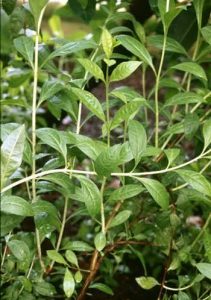BOTANICAL NAME: Lawsonia inermis
FAMILY: Lythraceae
ENGLISH NAME: Henna
COMMON NAME:
Hindi: Mehandi
Kannada: Goranta, Korate, Madarangi
Punjabi: Mehndi
Tamil: Marudum
Bengali: Mehadi

HABITAT: Native to Arabia and Persia; now cultivated mainly in Haryana and Gujarat; to a small extent in Madhya Pradesh and Rajasthan.
BOTANICAL DESCRIPTION: Small herb. Leaves simple, 2 to 3 cm in length, 1 to 1.5 cm in width, greenish-brown to dull green; entire, lanceolate; apex mucronate, base tapering, petiole short and glabrous; odor, aromatic when crushed; taste, sweet, mucilaginous and slightly astringent.
| RASA | GUNA | VEERYA | VIPAKA | PRABHAVA | DOSHGHNTA |
| Tikta,
Kashaya |
Laghu,
Ruksha |
Shita | Katu | Kapha Pitta Shamak |
AYURVEDIC ENERGETICS:
| TASTE | PROPERTY | POTENCY | POST
DIGESTIVE EFFECT |
EFFECT
ACTION |
DOSHA
ACTION |
| Bitter,Astringent | Dryness, lightness | cold | Pungent | Kapha pitta
Pacifying |
MAJOR CHEMICAL CONSTITUENTS: Glycosides, coloring matter (Lawsone), Hennotannic acid, Essential Oil containing β-Ionone.
THERAPEUTIC USES:
- Graying of hair-Mature leaves are made into fine paste. Apply this to scalp.
- Dysuria- 10-15 ml of fresh juice of leaves is added with 3-5 gram of sugar and
10-15 ml of fresh juice of Durva (Cynodon dactylon). This juice mix is administered in a dose of 15 ml, 2 times a day.
- Constipation– 5-10 gram of henna leaves and 5-10 grams of raisins are taken and fine paste is made. This is administered at night, after food in a dose of 10-20 grams.
- Jaundice- 1 fist full of each of Henna and Phyllanthus indica are taken and pounded with 10 grams of cumin seeds. This helps to mask the peculiar smell. Fresh juice is extracted and filtered. This, in a dose of 1–15 ml, is administered along with sweet buttermilk in the morning, on empty stomach.
INDICATIONS:
Jvara Fever, Kandu Worm infestations, Kushtha Skin disorders, Raktapitta Bleed disorders, Kamala jaundice, Vrana Wounds.
USEFUL PART: Leaves
DOSAGE: 5-10ml (Svarasa)
AYURVEDIC FORMULATION:
Madayanyadi Churna
